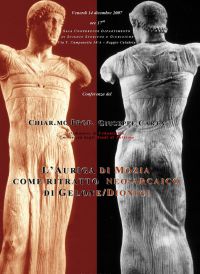Auriga and quadriga . . Sicilia in rete Sicilydistrict Culture Young Man of Mozia
 2023🔹 Sicily WEEKLY EVENTS GUIDE 🔹 Auriga di MOZIA 🔹 ritornato in Sicilia
2023🔹 Sicily WEEKLY EVENTS GUIDE 🔹 Auriga di MOZIA 🔹 ritornato in Siciliaopen expo Marsala - Panhellenic games
- Young Man of Mozia - The Olympic victory 🔹
Efebo (o auriga) di MOZIA - scultura in marmo del V sec. a.C - Museo Whitaker - isola di Mozia (Trapani) tra Marsala ed isola dello Stagnone - quasi lite tra istituzioni siciliane dello stesso Comune per ospitare il giovinetto di Mozia.
Dopo la trasferta all'Olimpiade di Atene, dopo altri 2 anni in giro per il mondo, dopo essersi mostrato ai visitatori di tutto il globo questo AURIGA - il guidatore di un cocchio di 2.500 anni fa, bello come un Apollo, pur di fargli fare altra sosta fuori casa, a Marsala, nel Baglio Anselmi, un piccolo museo ad appena 5 km da Mozia. La nostra preziosa statua si ferma ancora chissā per quanti mesi fuori Mozia - il giovinetto di Mozia - opera di indiscusso valore artistico e storico che da oltre 2 anni č in giro per il mondo nonostante sia stata da tempo inserita nell'elenco delle opere a cui č inibita l'uscita.
🔹2017 Auriga di Mozia - nuovamente in Expo in Sicilia - organizzata mostra di grande richiamo turistico e culturale
🔹MARSALA Baglio Anselmi - Auriga di Mozia open expo
Museo archeologico Lilibeo Marsala - Baglio Anselmi
via Capo Lilibeo MARSALA Trapani area Tel. : +39. 0923.952535
Orari ingresso : Tutti i giorni h 9-19
//////////////// ENGLISH VERSION🔹
THE MOZIA CHARIOTEER This extraordinary masterpiece of Classical marble statuary was discovered at Mozia, the earliest Phoenician colony in Sicily.
It is unique within the context of fifth - century Sikeliote and Magna Graecian and even mainland Greece CULTURE, owing to the contrast between the severe form of the head and the calligraphic rendering of the folds of the clothing, the unusual dynamism of the figure - arising principally from the torsion of the bust - and the exceptional sensuality suffusing the figure.
These qualities have made the statue the subject of heated debate since its discovery, and as a result the hypotheses concerning the iconography, dating, context, and the artist who created it have varied and are often conflicting.
Another factor that has complicated the interpretation is where it was found: a major city of the Phoenician West, which certain scholars are
disinclined to believe could have fostered works of such importance and so strongly representative of the CULTURE and ideology of the Greek world.
Given this, and taking the sculpture as an emblematic example of the mixing of Punic and Greek cultures typical of the Mozia area, some have identified it as the commission of a Greek artist to depict a figure belonging to the Phoenician - Punic cultural sphere.
The subject represented in this case has been identified as an Eastern priest or deity such as Baal, whose many epithets include divine charioteer, or even Herakles - Melqart, whose iconography is well known in the East and in Cyprus.
Although these hypotheses are rationally formulated and make a significant contribution to our knowledge of the iconographies of Eastern culture, scholars are now almost unanimous - at the current stage of the various iconographic, stylistic, and historical analyses of the statue - in identifying the figure as a victorious charioteer in the Panhellenic games, who stands in triumphant pose holding up a laurel wreath or some other symbol of victory.
This interpretation gives rise to the intriguing hypothes is that the statue might originally have been part of a monument erected at Akragas to commemorate the Olympic victory won of the tyrant Theron in the chariot race in 476 B.C., with the quadriga being driven by the charioteer Nikomachos.
It has also been hypothesized, however, that the charioteer depicted might he Thrasyboulos of the Emmenids.
The statue is therefore generally attributed to a major Greek master working during the period immediately preceding the mid - fifth century B.C., and it would have come to MOZIA as part of the war spoils from one of the Carthaginian victories in the final years of the fifth century over the richest and most powerful Sikeliote cities of the time - Selinous, Himera, Akragas, and Gela.
www.regione.sicilia.it/beniculturali/dirbenicult/database/page_musei/pagina_musei.aspID=32&IdSito=88&IdC=&IdS=&IdAS=
Memo: Archeo Greek world in Sicily, 🔹Auriga di Mozia ritornato in Sicilia open expo Marsala - Young Man of Mozia, Efebo (o auriga) di Mozia - scultura in marmo del V sec. a.C - Museo Whitaker - isola di Mozia (Trapani) tra Marsala ed isola dello Stagnone
. . . . 🔹
2023 🔹 Sicily and Mediterranean BE The First to Know about Events - The Portal www.SicilyDistrict.EU Chi DOVE in who Where inside our N. 1 TOP Sicily & Mediterranean Events & more - Day by day - website New news Date & Location
. . . . . . . . . . . . . . .🔹
2023 🔹SICILIA SicilyDistrict.EU Sicily Travel Guide - 2999 pages of tips and Useful information about Sicily 🔹

 ">
"> Airport & Airlines
Airport & Airlines Art
Art  Asia & Balcani
Asia & Balcani  Berlin Dus Koln Messen
Berlin Dus Koln Messen Cina
Cina classical oper dance
classical oper dance Concert & Tours
Concert & Tours Conference & Congress
Conference & Congress Cruise & Logistic
Cruise & Logistic Deutschland
Deutschland Euro Med
Euro Med Fairs & Festivals
Fairs & Festivals Flor Vivai & Parks
Flor Vivai & Parks GDO & Shopping map
GDO & Shopping map  Gourmet
Gourmet Hotel / Resort / B&B
Hotel / Resort / B&B Italian Districts
Italian Districts  Medicine & sanita
Medicine & sanita Olive Oil & Wines
Olive Oil & Wines Russia
Russia Sagre & Food
Sagre & Food Sport
Sport Top News
Top News Twins & more
Twins & more Musei open
Musei open
Commenti
Devi eseguire il Login per pubblicare un commento
Questo articolo non e' ancora stato commentato